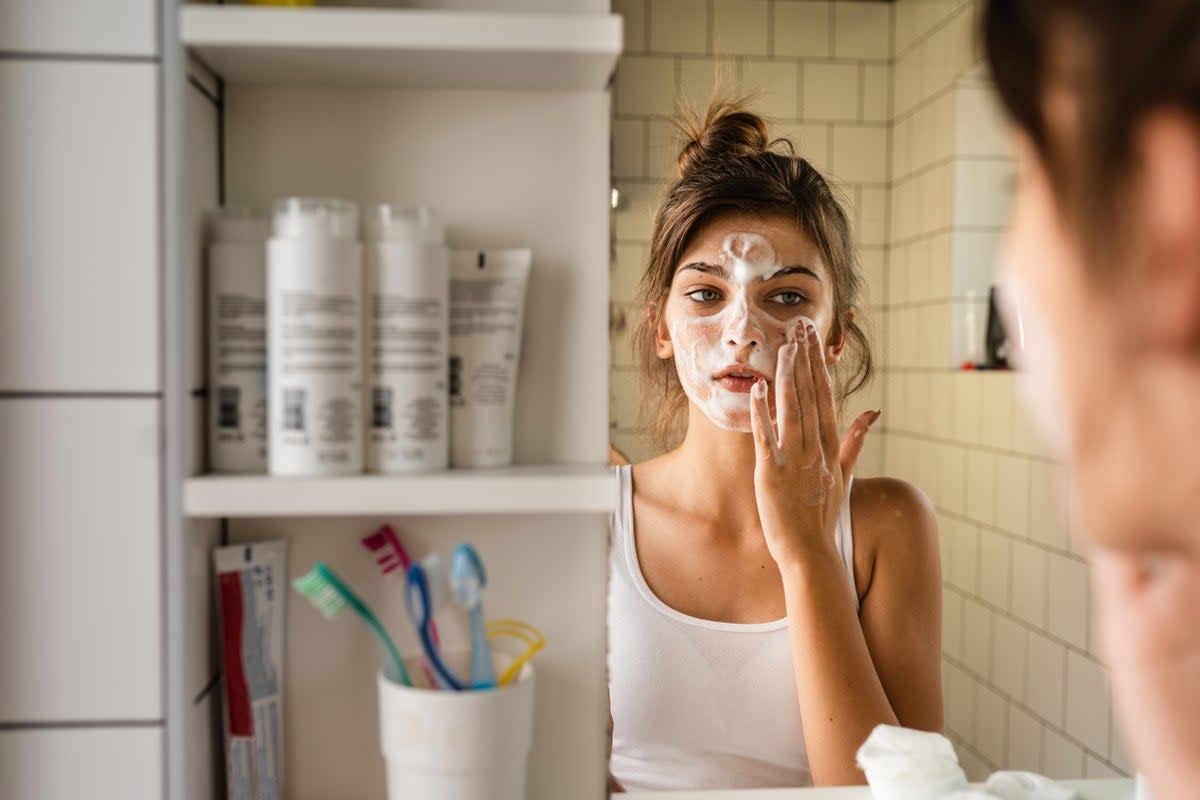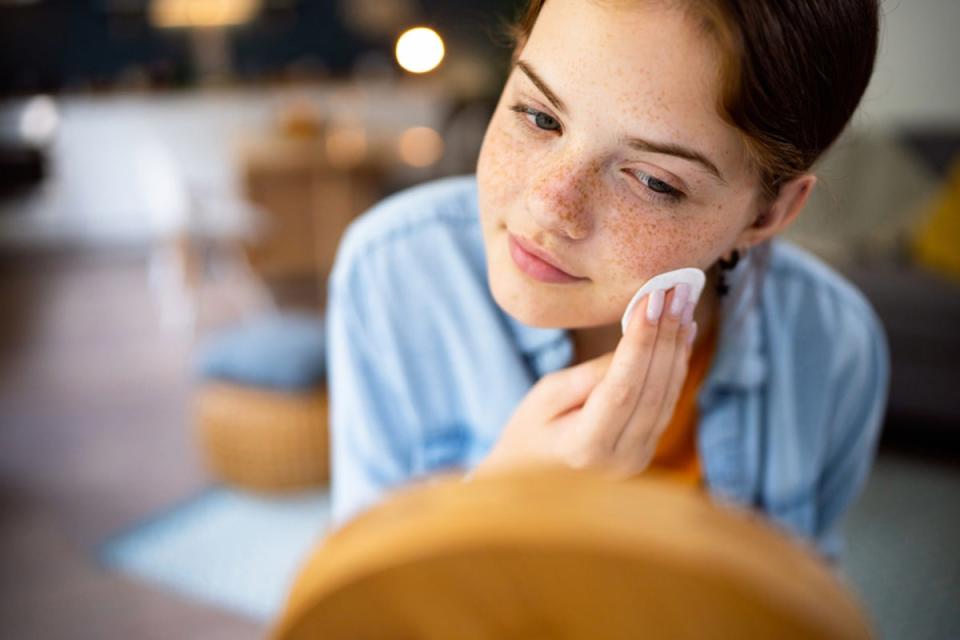The teen craze for anti-ageing products – and what it could really be doing to their skin

Teenage skincare once meant stocking up on an emergency bottle of Clearasil and praying that a massive spot wouldn’t erupt just in time for the under-18s disco. But if you ask parents about what teens are using on their faces now, the answer tends to sound like a stocktake at Space NK. Drunk Elephant, Glow Recipe, Sol de Janeiro: these high-end brands are now as beloved by 14-year-olds as they are by 40-year-olds. When the bank Piper Sandler surveyed the shopping habits of 5,690 teenagers last autumn, it found that spending on skincare had increased by 19 per cent since last year.
Clamouring over whatever pricey branded goods are “in” is practically an adolescent rite of passage (God bless Kookai bags and Lacoste perfume). The big difference here is that while, say, trainers and handbags are pretty much age-neutral, top-tier skincare has often been made with a much older customer (and their very specific complexion concerns) in mind. Last week, leading UK dermatologists told The Guardian that children as young as 10 are pressurising their parents to buy these pricey products, which often boast powerful ingredients – like retinol, acids or vitamin C – designed to minimise wrinkles and treat pigmentation from years of basking in the sun. Neither of these should be a concern for the average teen. So why are anti-ageing lotions and potions suddenly enjoying cult status among kids who, well, haven’t done any ageing at all? And what are all these potent ingredients doing to very young skin?
Dr Anjali Mahto, a consultant dermatologist and the founder of the Self London clinic, says she has “definitely noticed an increase in the number of teens coming into my clinic who are concerned about anti-ageing”. Just a few weeks ago, she adds, she met with a 14-year-old client “who was concerned about crow’s feet”. Mahto reckons this premature obsession with wrinkles “has absolutely been driven by social media, particularly TikTok, where teens are exposed to influencers showing their in-depth, often unnecessary skincare routine”.
Generation Alpha, born from 2010 onwards, has grown up fully immersed in digital culture. They don’t have to flick through Mizz magazine to glean some questionable beauty tips (does washing in cold water really make your hair shiny, or was that just a cruel psyop carried out by a bored journalist?). Instead, they have easy access to hours of “get ready with me” videos. In these snappily edited clips, photogenic influencers dab various serums onto already radiant faces, name-checking potent active ingredients in a way that makes them seem aspirational. A 2023 report on Generation Alpha from the marketing company Wunderman Thompson found that 55 per cent of six- to 16-year-olds want to buy a product if their favourite YouTube or Instagram star uses or wears it. The same year, a TikTok video went viral that showed a 14-year-old girl detailing “some things that I do to slow down the ageing process” (including applying face masks and retinol products twice a day).
Beauty PR Maria Stapleton has two young daughters aged 12 and 10. As she works in the industry, her kids have been interested in skincare from a young age but she has always tried to educate them about ingredients – and steer them away from products they don’t need yet. “They know that they can’t use my cleanser because it’s got a glycolic acid in it and that will be too harsh on their skin,” she says. Their friends, though, chat about using active-heavy products from brands like The Inkey List. “They hear the word ‘retinol’, they hear ‘salicylic acid’ [online] and they think, ‘I need that!’” she adds. “A little knowledge is a dangerous thing.”
She’s not the only parent to suggest that teens aren’t getting the whole picture about products through social media videos. Tej Patel, transformation specialist at Tej-Fit, has an 11-year-old daughter who started getting into skincare almost two years ago. She began with straightforward, high-street brands, Patel explains, “but then she started moving into wanting to put serums on, and overnight stuff”, telling her mum: “I’ve been watching these girls on TikTok and Instagram, they have amazing skin.” The videos she watches, Patel notes, “are very quick pieces of information – it’s 90 seconds, so they don’t have time to talk about the fact that this is for this type of skin or for this age”. Instead, “they make it all-singing, all-dancing” – catch-all solutions that inevitably appeal to teens who are often “hypersensitive, hypervulnerable and insecure” about their appearance.

Ninety seconds arguably isn’t enough time to properly explain all the nuances of using an ingredient like retinol. It’s a form of vitamin A which increases the turnover of skin cells and unblocks pores – used under the supervision of a dermatologist, it can be a godsend in the battle against acne. And it also helps boost collagen production, helping minimise the appearance of wrinkles. But it’s not something that anyone – let alone a 12-year-old – should start slapping on with abandon. It’s best to start off gradually, one day on, one day off: overapplying it, Dr Mahto notes, “can lead to irritation, redness and increased sun sensitivity” (on that note, it’s best applied at night then followed up with an SPF in the morning).
Unless they’ve been prescribed it as an acne treatment, teenagers just don’t need to be using retinol, says Dr Angela Twari, consultant dermatologist at GetHarley. At this age, she explains, your reticular dermis – that’s the thick, lower layer of the dermis (the middle segment of your skin) – is “still developing and producing more collagen”. So trying to boost this even further is superfluous: there might even be a risk that you’ll overstimulate collagen production and throw the skin’s natural cycle off-kilter, resulting in more irritation and even premature damage.
A young person’s skin barrier (that’s the protective outer layer of cells, which retains moisture and stops external stressors and toxins from getting in) is usually thinner than an adult’s. That means it’s more easily irritated by intense ingredients. Vitamin C, exfoliating acids such as AHAs and BHAs, niacinamide and salicylic acid are all popular with beauty-obsessed teens. But overusing them at a young age “can actually disrupt the skin barrier and cause certain conditions like dermatitis,” explains Dr Mahto.
The psychological impact is my main concern here. I don’t think it fosters a healthy relationship with ageing at all
Dr Anjali Mahto
Joanne Watkinson, co-founder of fashion brand By Elleven, initially welcomed her “skincare mad” daughter’s new interest; the 12-year-old has eczema and dry skin, and Watkinson “thought it would encourage her to reapply her moisturisers more frequently”. Soon, though, “she began to ask for [products from] Drunk Elephant and The Ordinary. All of the items she asked for contained active ingredients such as retinol and hyaluronic acid” (the latter helps skin retain moisture). Watkinson demurred but thanks to a Secret Santa present swap, her daughter ended up getting hold of the products: “Cue red, dry skin almost immediately.”
To make matters worse, some t(w)eens are throwing many of these ingredients onto their faces all at once – despite the fact that, say, using retinol after an acid-based cleanser is a recipe for sore, red skin. “Younger patients are actually layering a number of actives that I wouldn’t necessarily put together”, says Dr Twari. Conversely, she’s also seen “natural” TikTok beauty hacks go very wrong: she’s had a couple of patients come in needing antibiotics after applying flaxseed and water as a mask. They hoped for a Botox-like effect but got a skin infection instead.
It’s not just the potential for skin problems that troubles experts, though. “The psychological impact is my main concern here,” Dr Mahto says. “I don’t think it fosters a healthy relationship with ageing at all. We have a psychologist at my clinic and teen referrals have increased hugely over the past year for teens who have developed a complicated relationship with their skin, whether that’s because of acne or because they have become overly concerned with anti-ageing.” This is certainly a source of unease for parents like Watkinson, too. “The beauty standards [my daughter’s] generation are aspiring to worry me a lot,” she says. “The volume of pictures they take of their own faces can’t be healthy. I don’t think it’s vanity either: it’s as though their physical attributes hold their worth. I’m trying very hard to support her so it doesn’t become a problem.”
And behind all this is a persistent, quietly heartbreaking question: how have we managed to create a world where kids who’ve barely started living are already thinking about how to preserve their youth?


